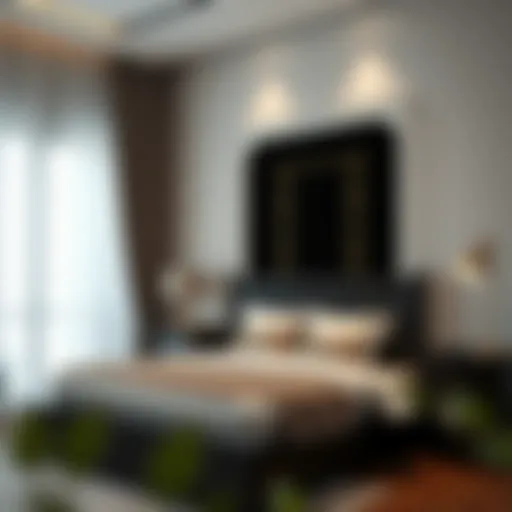Transform Your Kitchen with Bead Curtains: A Guide
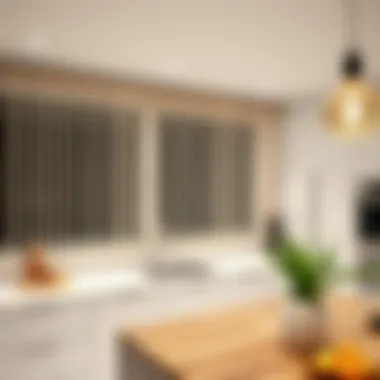
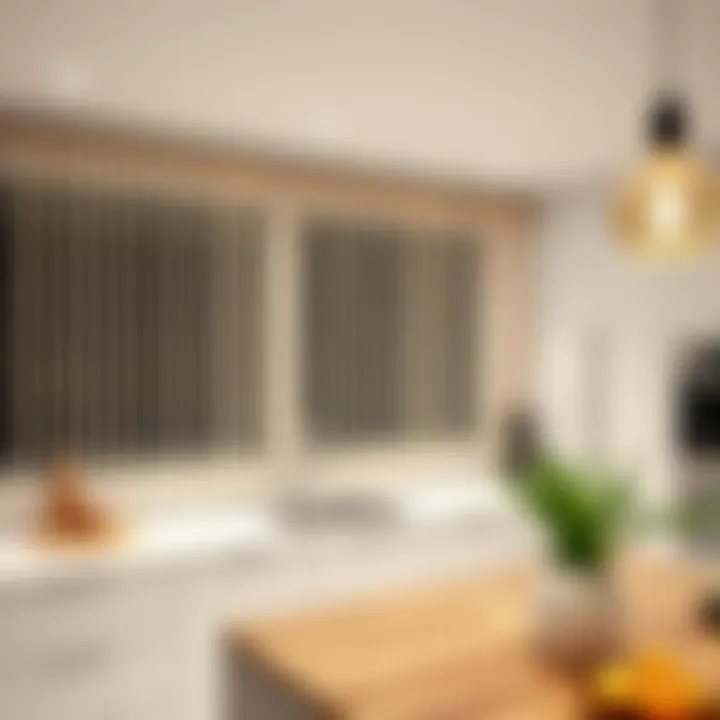
Intro
In the world of kitchen design, bead curtains often glide under the radar, overshadowed by more conventional decor elements. Yet, these decorative pieces are not just a mere afterthought; they serve a significant role in defining spaces while adding an eye-catching aesthetic touch. With various styles and materials at one's disposal, bead curtains provide a unique method of elevating kitchen aesthetics, creating warmth and subtly enhancing privacy.
From the bustling hubs of culinary artistry to calm breakfast nooks, understanding how to effectively incorporate bead curtains can be a game changer. Let’s explore the versatile aspects of bead curtains, their styles, installation methods, and practical maintenance tips, all while staying tuned to current trends that enrich home decor. Whether it's blending these curtains with vintage wood or sleek modern finishes, there’s a myriad of possibilities waiting to be discovered.
With this guide at your fingertips, feel free to dive into the delightful world of bead curtains, where every strand tells a story and every color brings a different flavor to your kitchen!
Furniture Design Trends
Current Trends in Furniture Design
A fresh breeze is sweeping through the realm of kitchen design. People today lean towards open-concept spaces that blur the lines between cooking and gathering. To complement this style, bead curtains can serve as a chic barrier that defines areas without closing them off entirely. The integration of natural materials like bamboo or glass beads reflects a desire for simplicity and connection to nature, resonating with trends toward sustainability and craftsmanship.
In terms of color palettes, muted tones mixed with pops of vibrant hues are increasingly seen in kitchens, and bead curtains can highlight those splashes of color beautifully. For example, a rich emerald green bead curtain serves not just as a functional divider, but also as an artwork in motion, capturing attention with each shifty glance.
Influential Designers to Follow
When considering the world of kitchen design, several visionary designers set the stage for forward-thinking ideas.
- Nate Berkus: Known for his serene and personalized interiors, he champions designs that blend functionality with aesthetics.
- Kelly Wearstler: With a flair for bold colors and textures, she curates environments that spark creativity, incorporating elements like bead curtains that can transform and add flair to a design.
- Joanna Gaines: Focused on the warmth of farmhouse style, she expertly combines rustic elements with modern twists; bead curtains could be an intriguing addition in her signature look.
These designers not only inspire, but they also push boundaries in furniture design, encouraging homeowners and decorators to explore new territories in styling, especially within the kitchen.
Practical Tips for Furniture Selection
Choosing the Right Materials
Selecting materials for bead curtains is paramount. The right choice can significantly impact the ambiance of your kitchen. Consider opting for:
- Wooden beads: They provide a warm, earthy vibe and integrate seamlessly into rustic and traditional designs.
- Acrylic beads: These can imitate glass but are more durable and come in varied colors, perfect for adding whimsy and playful styles.
- Metal beads: They add an industrial edge; how about metal bead curtains hanging between the kitchen and dining area?
Maximizing Space with Smart Furniture Choices
In smaller kitchens, it’s essential to create an illusion of more space. Bead curtains allow for visual separation without losing openness. When paired with minimalist furniture, they can contribute to an airy feel while defining each space effectively.
When selecting furniture for a kitchen that features bead curtains, prioritize multipurpose items. Think of a small dining table that expands for guests or rolling carts that can act as storage and prep space. This way, every inch counts, making your kitchen both functional and visually engaging.
"The beauty of bead curtains lies not only in their aesthetic appeal but in their ability to make your kitchen feel like home, defining spaces while keeping the warmth of togetherness alive."
Preamble to Bead Curtains
Bead curtains offer a distinctive way to infuse charm and functionality into kitchen designs. They’re more than just decorative elements; they serve practical purposes in defining spaces, enhancing ambiance, and adding character. As open-concept living spaces gain popularity, the demand for versatile solutions to separate areas has increased. Bead curtains provide an elegant alternative to traditional doors or walls while facilitating an airy feeling in the room.
In this guide, we will explore the multifaceted role of bead curtains in kitchen settings. We will decipher how they can promote both privacy and light diffusion, and process of selecting the ideal materials and styles that align with your personal decor schemes. Understanding bead curtains gives homeowners, decorators, and interior designers a tool to elevate their spaces creatively and efficiently.
Understanding Bead Curtains
Bead curtains, consisting of strings of beads hung from a frame, create openings that act as both partition and passageway. These curtains can vary widely in size, bead type, and color, allowing for immense flexibility in design to match any kitchen aesthetic. From wooden beads that evoke a rustic feel, to acrylic options for a modern flair, the selection is both vast and varied.
One prime advantage of bead curtains is their ability to manage light. They can soften harsh sunlight, preventing an overload of brightness in your cooking space. This feature not only enhances comfort but also adds a layer of artistic dimension to the environment. When properly placed, bead curtains can act as a visual guide, subtly leading guests through the cooking area without creating the stark boundaries of traditional walls.
The Historical Context of Bead Curtains
The history behind bead curtains is as diverse as the cultures that have adopted them. Often traced back to ancient civilizations, these hanging adornments were not purely functional; they held social and symbolic uses. In many cultures, such as those in Asia, bead curtains served to separate living areas from workspaces while also warding off insects, showcasing both pragmatic and aesthetic purposes.
Fast forward to the mid-20th century, bead curtains reigned supreme in bohemian and psychedelic households, symbolizing freedom and creativity. Their retro appeal has found its way back into contemporary home decor, making them a desired accessory once again. While their form may have evolved, the fundamental purpose remains unchanged: bead curtains still bridge spaces in an inviting manner.
Ultimately, understanding the historical significance behind bead curtains adds depth to their appeal. It leads to a greater appreciation of their versatility in modern kitchen design, grounding the contemporary choice in rich cultural heritage. Through the examination of their roots, homeowners can choose their bead curtain styles with awareness of not only visual effects but also the narratives they carry.
Functional Benefits of Bead Curtains in the Kitchen
When thinking of bead curtains for a kitchen, it's essential to grasp the multiple functional benefits that they bring to the table. They do more than simply hang from a rod or doorway; they redefine the kitchen space in ways that other design elements might not. Bead curtains can be a clever mix of practical functionality and aesthetic appeal. Let's unpack this further.
Space Division and Privacy
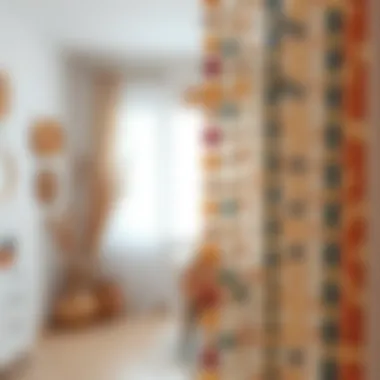
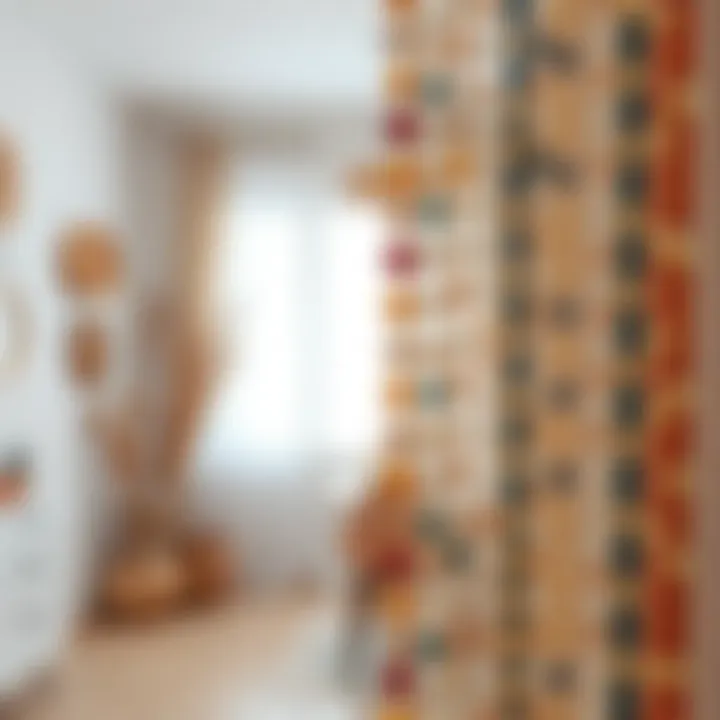
One of the most immediate benefits of bead curtains is their strategic use in dividing spaces. A kitchen, often the heart of the home, can multitask as a cooking zone and an entertaining area. Imagine having a small kitchen island that you also use for casual dining or a workspace. Bead curtains can create a distinction—cascading down in vibrant colors, they signal a different function without completely closing off the area.
Additionally, privacy is a valuable aspect in a bustling household. Unlike solid doors, which can feel confining, bead curtains offer a sense of separation while keeping the ambiance light and airy. This easy-going transition allows cooks to maintain visibility toward guests while still establishing functional barriers. It’s like having the best of both worlds!
"Bead curtains can offer a visual but soft barrier, making a space feel open yet defined."
- They come in various materials that can suit the prevailing kitchen decor. For instance, wooden beads could add a rustic touch, while glass beads could bring an elegant feel.
- Perfectly versatile, they can be repositioned or replaced depending on changing tastes or needs, ensuring that your kitchen remains a reflection of your lifestyle.
- They're low-maintenance, adding to their appeal as a practical option in a busy space.
Light Diffusion and Aesthetics
Light in a kitchen is crucial, influencing everything from functionality to mood. With bead curtains, light diffusion becomes an art. When natural daylight filters through the beads, it creates intricate patterns that change throughout the day. This soft illumination can make the kitchen feel more inviting, and who wouldn’t want that?
Moreover, bead curtains serve not just a practical purpose but also an aesthetic one. They come in an array of materials, colors, and styles, allowing homeowners to express their individual taste. Want to channel that bohemian vibe? Opt for colorful glass beads. Aiming for a chic and sophisticated flair? Then consider minimalist wooden beads in muted tones.
- More than decoration, bead curtains can also play on space perception. They can make a room appear larger as light flows unobstructed throughout the area.
- Mixing different shapes and sizes of beads can create visually engaging designs that enhance the overall decor.
- Tailoring their look to seasonal changes can keep your kitchen interesting and vibrant.
In summary, bead curtains stand out not only in terms of their functional benefits such as space division, privacy, and light diffusion but also for their versatile aesthetic. They are a simple yet effective way to elevate your kitchen while addressing essential practical needs as well.
Choosing the Right Material and Style
When it comes to bead curtains in the kitchen, selecting the right material and style is a crucial step that can make or break the aesthetic you're aiming for. The choice of material heavily influences not only the appearance of your space but also its functionality and maintenance needs. A well-selected bead curtain can evoke a specific ambiance, whether it's rustic, contemporary, or somewhere in between. This section will help you explore various materials and styles that align with your vision.
Types of Beads: Wood, Plastic, Glass
Different materials lead to vastly different vibes in any space.
- Wood Beads: These introduce a natural, organic feel to your kitchen. Richly grained wooden beads can turn a simple entryway into a charming rustic nook. They not only serve a functional purpose but also act as an aesthetic companion to wooden cabinetry or shelves. However, wood requires a bit more care to keep it looking its best, as humidity and heat could warp or damage it over time.
- Plastic Beads: Practical and varied, plastic beads come in endless colors and shapes, allowing a homeowner to easily match their kitchen decor. They are lightweight and easy to clean, but may not provide the sophisticated look that wood or glass can offer. Still, they offer flexibility for those who like to change their kitchen themes often, given that they are typically more budget-friendly.
- Glass Beads: For an eye-catching effect, glass beads reign supreme. They refract light magnificently and can add a touch of elegance to a kitchen. While glass presents a stunning visual dynamic, they are generally more fragile and may require careful installation or a higher level of maintenance.
Color and Pattern Selection
Choosing the right colors and patterns is like selecting a palette for a canvas; it defines the mood and intention behind the space. The kitchen has often been described as the heart of the home, and thus, it should reflect vibrancy or calmness as desired.
When picking colors, consider the existing hues in your kitchen. If your counters are dark, a set of lighter beads can create a striking contrast. Likewise, if your kitchen is quite neutral, a fun, bold pattern could provide the pop that the space needs. Patterns can include geometric shapes, floral designs, or even abstract compositions; the key is to ensure that they harmonize with the overall design.
- Tips for Color Selection:
- Assess the color wheel; complementary colors can elevate your kitchen's style.
- Consider seasonal changes and how different colors may enhance or detract from the space over time.
- Test small sections first to see how they interact with lighting at different times of the day.
Cultural Influences on Design
The selection of bead curtains can often be closely tied to cultural inspirations. Different cultures have their unique approaches, which can greatly influence your choice when setting the tone for your kitchen. For example:
- Bohemian Styles: The eclectic and free-spirited flair of Bohemian design encourages variety. Bead curtains featuring a mix of textures, colors, and patterns resonate with this philosophy.
- Asian Influences: In many Asian cultures, bead curtains made with bamboo or natural fibers emphasize balance and nature, creating a serene kitchen environment.
- Mediterranean Elements: Flowing bead curtains adorned with vibrant glass can lend that Mediterranean edge, providing a lively atmosphere reminiscent of sunlit terraces.
By thoughtfully considering the materials, colors, and cultural influences that resonate with you, the implementation of bead curtains will not just enhance your kitchen's functional aspects but also create an environment that reflects personal style and identity. Each choice beckons you to redefine your kitchen space, marrying creativity and practicality, and setting the stage for interaction and comfort.
Installation Techniques for Bead Curtains
Bead curtains have been a charming addition to kitchens, offering both functionality and style. However, the success of their implementation largely hinges on proper installation. Getting it right ensures that the curtains operate smoothly and effectively enhance the aesthetic of your space. From tools to techniques, understanding installation is essential for achieving the desired effect in your kitchen.
Tools and Materials Required
Before embarking on the installation journey, it’s critical to gather all necessary tools and materials. This preparation can save a lot of hassle down the line. Here’s a rundown of what you might need:
- Bead Curtains – Select the style and material that complements your kitchen design.
- Measuring Tape – Accuracy is key when measuring the space where the curtains will hang.
- Level – To ensure that the curtain rod or track is straight for a professional look.
- Drill and Drill Bits – Required for making holes in the wall or ceiling.
- Screws and Wall Anchors – Important for securing the rod or track firmly in place.
- Step Ladder – This might come in handy depending on the height of the installation area.
- Screwdriver – To tighten any screws that will secure your installation.
- Pencil – For marking measurements accurately on the wall or ceiling.
Having everything ready before starting the installation minimizes potential interruptions, allowing for a more fluid and efficient process.
Step-by-Step Installation Process
Once you have all your tools and materials, it’s time to dive into the installation itself. Following a clear process helps streamline the effort and ensures you don’t miss any important steps:
- Measure Your Space:
- Choose Mounting Locations:
- Mark Drill Points:
- Drill Holes:
- Install the Rod or Track:
- Hang the Bead Curtains:
- Use the measuring tape to ascertain the width of the opening where you plan to install the bead curtains. A precise measurement prevents the curtains from being too wide or too narrow.
- Decide where the rod or track will be mounted—this could either be on the wall or the ceiling above the entryway.
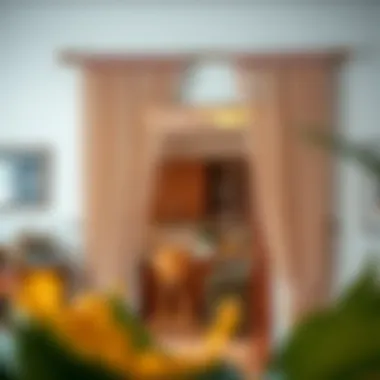
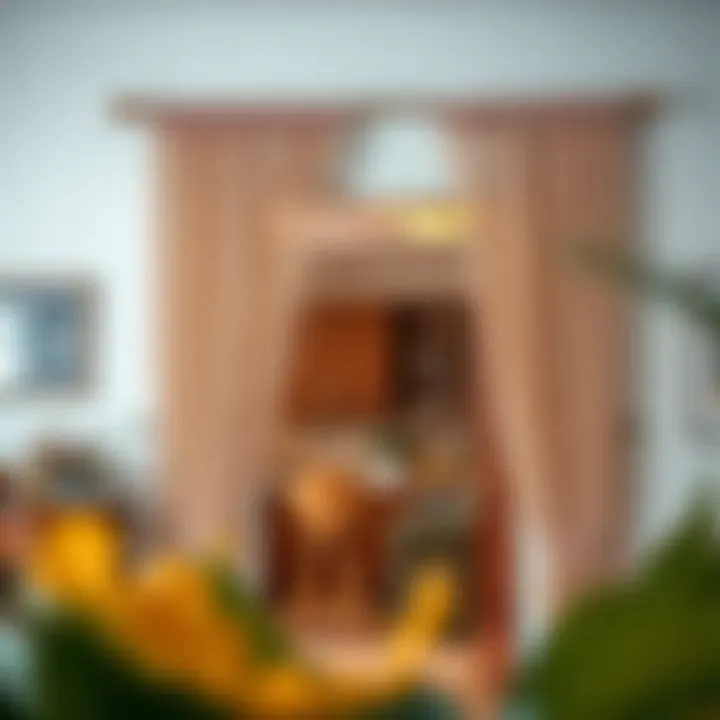
- With the pencil, mark where each screw hole will go based on the width and mounting choice. It’s wise to use a level to double-check your marks—all good things come to those who measure right!
- Carefully drill the holes at the marked points, ensuring that they are deep enough to accommodate wall anchors if needed.
- Secure the curtain rod or track into place using screws and wall anchors. Make sure it’s firmly fixed, as this will hold the weight of the bead curtains.
- Finally, after securing the rod or track, hang the bead curtains according to the manufacturer’s instructions. Ensure they're evenly distributed for the best effect.
Following these steps will ensure your bead curtains are installed correctly, enhancing both the functionality and aesthetic appeal of your kitchen.
Common Installation Mistakes to Avoid
Even the most seasoned DIYer can fall prey to common installation missteps. By being aware of these pitfalls, you can sidestep them:
- Incorrect Measurements: Failing to accurately measure the space can lead to curtains that are either too short or too long, disrupting the intended flow.
- Neglecting to Use a Level: If the rod or track isn’t level, the curtains won’t hang properly, which can detract from their visual appeal.
- Skipping Wall Anchors: In cases where heavy bead curtains are used, neglecting wall anchors can cause the rod to pull out from the wall, leading to damage and frustration.
- Over-tightening Screws: Going overboard with screws can damage the mounting surface and lead to instability over time.
By keeping these potential hiccups in mind, you can approach your bead curtain installation with greater confidence and success.
Always remember: proper installation not only enhances the beauty of your bead curtains but also prolongs their lifespan, making your kitchen a more inviting space.
Maintenance and Care for Bead Curtains
Taking care of bead curtains is crucial to ensure they maintain their charm and function over time. These unique decorative elements can add character to your kitchen, but neglecting them can lead to dullness or, in some cases, damage. Keeping them in prime condition not only prolongs their lifespan but also ensures that they continue to enhance the aesthetic appeal of your space. Regular maintenance is essential, as bead curtains can collect dust, greasy residues, and even pet hair, especially in a kitchen environment where food preparation occurs.
Cleaning Techniques for Different Materials
Cleaning bead curtains isn't a one-size-fits-all job. The materials used to make the beads can differ, and each type requires special care. Here’s a deeper dive into appropriate cleaning methods based on material:
- Wood Beads: For wooden bead curtains, avoid soaking them as moisture can warp the wood. Instead, use a damp cloth to wipe each bead. A mixture of mild soap and water can also be used gently. After cleaning, dry them well to prevent moisture absorption.
- Plastic Beads: These beads tend to gather dust easily. A quick solution is to use a handheld vacuum to remove loose particles. If more thorough cleaning is needed, wash them in warm, soapy water; rinse well, and allow to dry completely before rehanging.
- Glass Beads: Glass is more delicate and should be handled with care. Use a soft microfiber cloth and a gentle glass cleaner to avoid scratches. For tough grime, a vinegar-water solution is effective and less harsh. Just be sure to dry them properly to avoid streaks.
By ensuring you follow these specific cleaning techniques, you can keep your bead curtains looking sharp and vibrant, just like the day they were installed.
Preventing Damage and Wear
Preventing damage to bead curtains is as important as cleaning them. Here are a few tips for avoiding wear and tear, thereby extending their longevity:
- Mind the Traffic: If your kitchen has high foot traffic, consider strategically positioning bead curtains to avoid continuous collision. Practically, you might hang them in less frequented doorways or use a wider opening to minimize impact.
- Regular Checks: Examine the beads regularly for signs of wear, such as cracks in glass or splintering in wood. Catching these before they worsen can save you headaches down the line.
- Sunlight Considerations: Be aware that prolonged exposure to direct sunlight can cause fading in colors and warp certain materials. Consider positioning your bead curtains away from direct sunlight or using UV-protective coatings where applicable.
By taking these proactive steps, you can maintain the quality of your bead curtains, ensuring they not only look good but also serve their purpose efficiently.
"A little maintenance goes a long way in keeping your bead curtains pristine and vibrant."
Trends in Kitchen Decor Involving Bead Curtains
Bead curtains have seen a resurgence in kitchen decor, bringing a fresh twist to this often-overlooked aspect of interior design. They serve not only as a functional element but intertwine with the latest trends to enhance the overall aesthetic. From providing a visual divide between spaces to adding a pop of color, the current trends in bead curtains reflect a move towards personalization and creativity in culinary spaces.
Minimalist Approaches
Minimalism is all about simplicity, and bead curtains can play an essential role in this design philosophy. They can provide a light touch that doesn't overwhelm the senses while still offering the necessary delineation of spaces. A popular choice is opting for bead curtains with clear acrylic beads or thin metal chains. These options can offer a clean, sleek appearance and allow light to flow freely, maintaining an open feel throughout the kitchen.
- Less is More: Focus on transparency or neutral colors that seamlessly blend with the surrounding decor.
- Subtlety in Design: Avoid overly elaborate patterns that might clutter the clean lines of a minimalist kitchen.
Such choices ensure that the bead curtains contribute to the room rather than dominate it, creating a serene environment that's easy on the eyes.
Bohemian Influences
On the other end of the spectrum lies the eclectic and vibrant world of Bohemian decor. Bead curtains fit wonderfully here, allowing for a rich expression of culture and individualism. They can be made from a variety of materials such as wooden beads or colorful glass, reflecting the warmth and character that Bohemian design embodies.
- Layering Textures and Colors: Incorporate curtains with varied bead sizes and hues to add depth.
- Cultural Stories: Choose bead curtains that tell a story, perhaps featuring designs inspired by different cultures, which will resonate well in a stylized kitchen setting.
Such curtains can act as stunning focal points, making the room feel alive with creativity and artistic flair.
Eco-Friendly Designs
Sustainability remains a significant trend in home design, and bead curtains can contribute to this ethos. Choosing curtains made from natural materials like bamboo or reclaimed wood aligns perfectly with eco-friendly principles. Not only do these options bring in earthy aesthetics, they also reflect a commitment to reducing one’s carbon footprint.

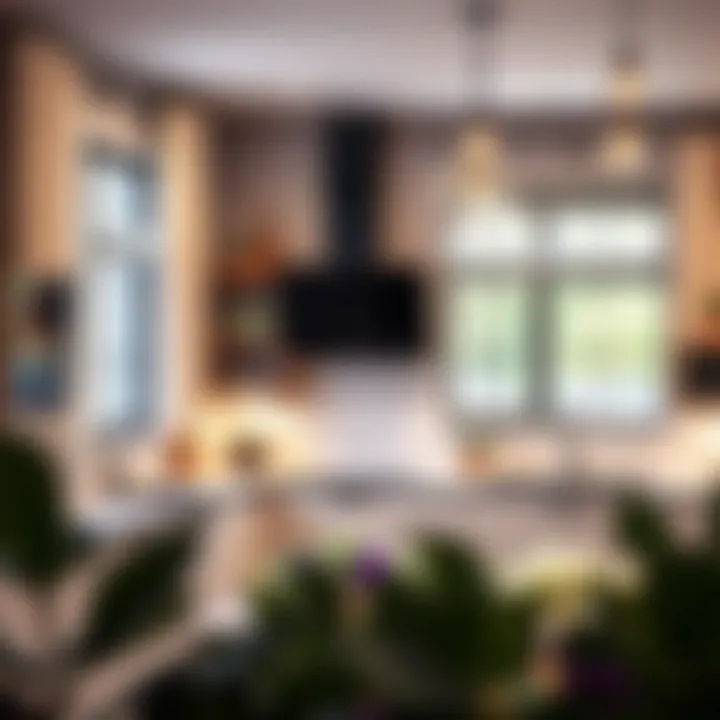
- Natural Materials: Opt for sustainable sources or upcycled materials that contribute to a greener environment.
- Biodegradable Beads: Consider using beads made from biodegradable materials, which are not only stylish but environmentally conscious.
Moreover, incorporating such designs shows a dedication to thoughtful consumption, which can resonate well with environmentally aware homeowners and designers alike.
"Bead curtains not only define spaces but also provide an opportunity to embrace current trends in kitchen decor that reflect personal values and style."
Practical Tips for Incorporating Bead Curtains in Your Kitchen
When it comes to enhancing the aesthetic and functional value of your kitchen, bead curtains can be a real game changer. Implementing bead curtains isn't just about hanging some decorative that sways in the breeze; it’s about making thoughtful decisions that cater to your specific needs and the ambiance of your space. Here are some practical aspects to consider which will help you effectively incorporate bead curtains in your kitchen.
Assessing Your Space
Before you dive headfirst into choosing a bead curtain, take a good look around your kitchen. Think about the layout, light sources, and existing furniture. First things first, measure the entrance or the area where you plan to hang the beads. Ensure you have sufficient clearance so the curtain can sway without obstruction.
Don’t underestimate the role of light in your decision. Bead curtains can let in a soft glow, enhancing the warm vibes of your kitchen. However, if you have an overly small or dark space, a denser curtain may feel cramped. Conversely, if your kitchen is sunny and spacious, a lighter, airy design could match that bright energy. Checking how traffic flows through your kitchen can also help you decide where a bead curtain might work best. Areas with high traffic might need sturdier sheens that withstand daily wear-and-tear.
Complementing Existing Decor
Now that you've assessed the space, it’s time to think about how your new bead curtain will gel with your current decor. Does your kitchen lean towards a modern look or is it more rustic? Matching or contrasting styles can create a fantastic visual dynamic.
- Modern Kitchens: Opt for beads made from acrylic or glass with clean lines and bold colors. Choices like translucent bead curtains can maintain an open feel while adding subtle texture.
- Rustic Designs: Wooden bead curtains can add an earthy touch that harmonizes beautifully with natural materials in your cabinetry and countertops. A color palette inspired by nature, such as browns and greens, can blend seamlessly.
- Color Coordination: Based on your existing colors, choose beads that either match or provide a complementary pop. If your kitchen has a neutral tone, a vibrant bead curtain can become a focal point and liven things up without overwhelming the senses.
Also, consider the patterns of your decor items. If your kitchen has tile with intricate print, a simpler bead curtain can provide a pleasant contrast without competing for attention.
In sum, bead curtains can infuse personality into your kitchen while offering practical benefits like space division and light enhancement. Keeping these practical tips in mind will help you navigate your choices in style and function, elevating your kitchen design to the next level.
Potential Drawbacks of Bead Curtains
While bead curtains can certainly elevate the kitchen’s aesthetic appeal and functionality, they come with their own set of challenges and considerations that should not be overlooked. Understanding these potential drawbacks is crucial for anyone considering bead curtains as a decorative feature in their kitchen. Each drawback illustrates practical implications that may influence your choice of this stylish element.
Challenges in Cleaning
One of the most significant concerns with bead curtains is their cleaning requirements. Traditional curtains might just require a good shake or a quick machine wash to keep them tidy. However, bead curtains can be a different kettle of fish. Depending on the material, they might accumulate dust, grease, and grime—especially in a kitchen environment where cooking activities often lead to splatters and spills.
- Material Matters: Wooden beads can soak up moisture and odors, while glass beads might attract fingerprints. Plastic can be easy to wipe down but may not have the same charm as other materials.
- Cleaning Methods: The most effective way of keeping bead curtains clean may involve a thorough hand cleaning, which can be labor-intensive. For those who lead busy lives, this cleaning process might become cumbersome, and over time, the effort can wear thin.
- Maintenance Frequency: Depending on your kitchen's traffic and cooking habits, you might find yourself needing to clean your bead curtains more often than expected, adding an extra task to your housekeeping duties.
In terms of practicality, if you envision a low-maintenance kitchen—where time spent cleaning and maintaining decor items is minimal—bead curtains might not be your ideal choice.
Suitability for Different Kitchen Types
Bead curtains display versatility, but their fit in specific kitchen styles can vary dramatically. Not every kitchen design can accommodate the casual charm of bead curtains, and understanding this compatibility is vital before making a commitment.
- Open vs. Closed Space: In an open kitchen, bead curtains can serve as decorative space dividers. However, in a compact kitchen, they could make the space feel cluttered or even impede movement. If your kitchen is tight on room, you might want to weigh this consideration carefully.
- Design Cohesion: The overall aesthetic of your kitchen plays a considerable role. For modern or minimalist designs, bead curtains may clash, whereas they could mesh seamlessly in bohemian or country-style kitchens. It’s about achieving a balance between styles and ensuring that every element works together.
- Functionality Needs: Certain kitchen types, especially those designed for heavy cooking, might benefit from solid doors that provide better insulations and privacy than bead curtains can offer. Consider how often the kitchen will be used for meal prep and entertaining before making a decision.
"A well-informed choice is the backbone of any home design. Evaluating where bead curtains fit within your kitchen's layout and function is essential."
In summary, while bead curtains bring charm and style to the kitchen, they also come with cleaning challenges and may not suit every kitchen style. It’s essential to weigh these drawbacks against the benefits before committing to this design element. By doing so, you can ensure that your kitchen remains not only beautiful but also practical.
Epilogue: The Role of Bead Curtains in Kitchen Design
Bead curtains are more than just decorative elements; they embody a blend of functionality and style within today’s kitchens. Their appeal goes beyond aesthetics, largely due to their unique ability to transform spaces. In an open concept design, for instance, bead curtains act as a subtle divider without completely altering the room's flow. They maintain an airy feel, which is essential in a bustling kitchen where practicality and charm need to coexist.
When considering the placement of bead curtains, their contributions to sound absorption and privacy become evident. This is particularly significant in households where kitchens transform into social hubs. People can cook, eat, and engage in conversation all at once, and bead curtains offer a little peace of mind and separation when needed. Additionally, they serve as an engaging focal point, setting the kitchen's personality—whether warm and rustic or vibrant and modern.
The choice of materials—be they wooden beads that harken back to nature or colorful glass for an artistic touch—also plays a crucial role. Homeowners can easily tailor the mood of their kitchen by selecting beads that complement or contrast with existing décor. Likewise, patterns can reflect personal style or cultural influences, adding layers of richness.
While bead curtains can have challenges, like cleaning and suitability concerns, the benefits often outweigh them. Households can find ways to maintain their allure with careful choice of material and proper upkeep. Moreover, as styles evolve, so do the possibilities of bead curtains adapting to trends. Thus, they remain a resilient choice in kitchen design that offers flexibility and creativity.
"Bead curtains can redefine the kitchen experience, harmonizing functionality and design in delightful ways."
In summary, bead curtains should not be overlooked when designing or redesigning spaces in the kitchen. They bring to the table a variety of benefits from supporting privacy and defining areas to contributing visually to the ambiance. As long as homeowners remain aware of their potential pitfalls and make informed choices, bead curtains stand the test of time as a dynamic element of kitchen décor.
Summarizing Key Points
- Functionality: Bead curtains provide space division and sound absorption, enhancing the usability of the kitchen.
- Aesthetic Appeal: They contribute significantly to overall design, allowing for customization that can reflect personal style or cultural influences.
- Versatility: Applicable in both modern and traditional kitchens, bead curtains can adapt to evolving design trends while maintaining their practical role.
- Maintenance Needs: While some drawbacks exist, proper material choice and care can mitigate issues and keep bead curtains looking their best.
Future Considerations for Bead Curtains
As we look towards the future in kitchen design, bead curtains are likely to evolve alongside emerging trends in interior decorating. Here are several predictions:
- Technological Advances: New materials could emerge, offering easy maintenance options or enhanced durability. Nanotechnology might change how we think about cleaning and caring for bead curtains.
- Sustainability Trends: Eco-friendly materials might dominate, allowing homeowners to choose beads sourced from renewable resources or made through sustainable practices.
- Smart Design Elements: Integrating bead curtains with smart home technology and automated systems could add further convenience, allowing them to open or close based on room temperature or privacy needs.
- Cultural Revival: As artisanal and handmade products are celebrated, we may see a rise in unique bead curtain designs, tapping into local craftsmanship and restoring traditional techniques.
Bead curtains will continue to appeal to those who value both functionality and aesthetics in their designs. As this notion of holistic living spreads, their role in kitchens will likely grow even more relevant, reflecting the constantly shifting landscape of home interiors.



